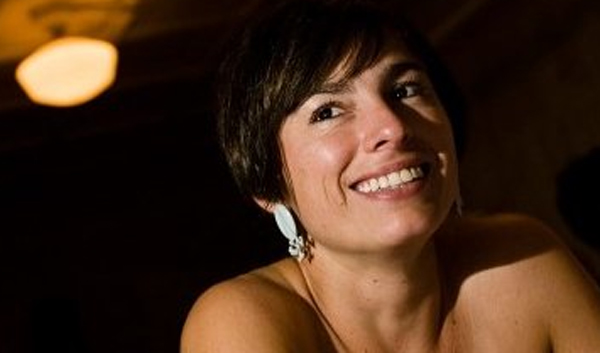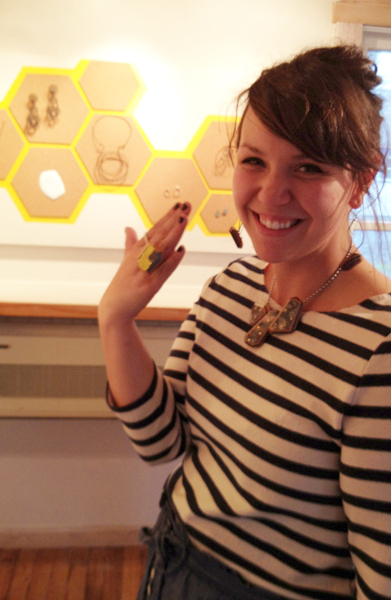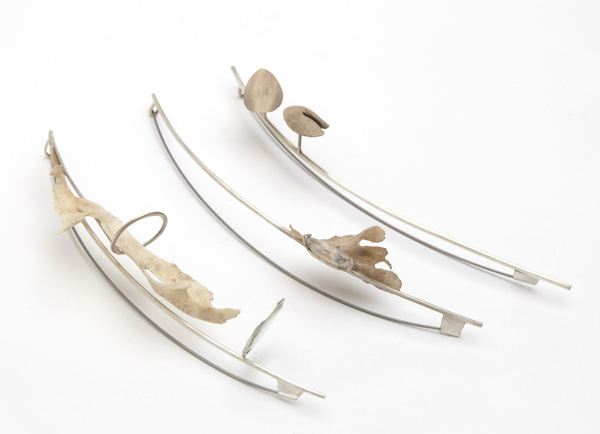
Susan Cummins: AJF featured you and your gallery in the July newsletter so I don’t want to repeat the questions asked, but for the sake of this interview, can you give me a short version of the story of how you decided to run a jewelry gallery?
I have always been drawn to the museum/gallery sector of the art world. As an undergrad I worked at the Baxter Gallery at Maine College of Art. The director, Jennifer Gross, was a great mentor and she allowed me to participate in all aspects of the gallery. At SUNY I realized how few places the public has to experience art jewelry. Opening a gallery was a way to realize a dream of mine and contribute to the field in general. After grad school I moved to New York City to work at Leo Koenig Inc., a contemporary art gallery in the heart of Chelsea. This experience helped me to understand the logistics of running a gallery, but did not provide a model that I could see myself owning. It was not until I visited Dunedin in New Zealand that I found a gallery that spoke to me. The gallery, Lure, was run by artists, showed many artists’ work and provided a fun and inviting space for the public to interact with art jewelry. This solidified my vision and I opened the gallery three months after returning from New Zealand.

Susan Cummins: AJF featured you and your gallery in the July newsletter so I don’t want to repeat the questions asked, but for the sake of this interview, can you give me a short version of the story of how you decided to run a jewelry gallery?
I have always been drawn to the museum/gallery sector of the art world. As an undergrad I worked at the Baxter Gallery at Maine College of Art. The director, Jennifer Gross, was a great mentor and she allowed me to participate in all aspects of the gallery. At SUNY I realized how few places the public has to experience art jewelry. Opening a gallery was a way to realize a dream of mine and contribute to the field in general. After grad school I moved to New York City to work at Leo Koenig Inc., a contemporary art gallery in the heart of Chelsea. This experience helped me to understand the logistics of running a gallery, but did not provide a model that I could see myself owning. It was not until I visited Dunedin in New Zealand that I found a gallery that spoke to me. The gallery, Lure, was run by artists, showed many artists’ work and provided a fun and inviting space for the public to interact with art jewelry. This solidified my vision and I opened the gallery three months after returning from New Zealand.

I am from Rehoboth Beach, Delaware and I realized the location could work because of the influx of people vacationing here every year. Since I opened seven years ago, Rehoboth’s year round crowd has grown and my business has grown with it. Rehoboth Beach is a resort town that swells to three times its capacity in the summer. Most of the tourists come from the surrounding cities: New York, Baltimore, Washington DC and Philadelphia. Rehoboth is quaint and filled with great food, art and shopping.
Given your training as a metalsmith I noticed that you are also providing classes in the gallery. How does that work? Who takes the classes?
Teaching is something that comes naturally to me. I teach many different people, including college students at Towson University, the mentally and physically disabled at Stockley Center, workshops for highs school students and individuals at my studio. Those who take the private lessons are usually people who started in a college setting or continuing studies, moved to Rehoboth and wanted to continue their training. Some of my students have been with me for over five years. The group classes grew out of a demand. So many people asked about classes that this summer we started to offer small classes based on a particular skill. What I have realized is that this is an instant way to instill an appreciation for handcrafted jewelry and create a dedicated following.
What book have you relied on to give you the best insight into contemporary jewelry?
I just went through a Glenn Adamson phase. I read The Craft Reader and Thinking Through Craft. I also have Artists With PHDs and SchmuckDenken in process on my bedside table. I am constantly working through three or four books at a time.

Desire began when I came to Heidi Lowe with a show proposal in the spring of 2011. I had noticed a micro-trend within art jewelry dealing with the subject of preciousness and desire and was interested in investigating artists covering this topic. While alternative materials and the idea of substituting the gemstone had been done in many variations, I was responding to the works of artists with a heightened material awareness. Desire is rooted in an emotional and visual connection to the work and the challenge in investigating its ability to create a longing for the object. The word desire within the context of the show is referring to the history of longing within decorative objects, specifically jewelry. Artists of both the past and present have made work that comments on this. However I feel that these artists are redirecting the conversation through their choice and treatment of materials.
Where you aware of the artists – Courtney Kemp, Jimin Park and Lauren Griffiths – before you came up with the idea or did you discover them later?
Equally inspired by both the artists and the idea, it wasn’t until finding the right artists that the show really came together. I have been familiar with both Jimin Park and Courtney Kemp’s work over the past years. Lauren Griffiths had approached Heidi Lowe with her work and I knew instantly that her work would be perfect for rounding out the show.
What is your background? Are you a jeweler?
I graduated from the University of Oregon under the teaching of Anya Kivarkis in the spring of 2005 with a Bachelors of Fine Arts in Jewelry and Metalsmithing. I am trained as a jeweler, but find myself invested more in the world of curation and installation of shows. During my time as an intern and employee at Heidi Lowe Gallery, I quickly developed a passion for the front of house. My time there led me to the internship at the MoMA PS1, as well as a new interest in install and design. While there, I quickly learned the inner and outer workings of a large-scale art museum, which I felt prepared me to curate Desire.

Over the past few years I have found myself interested in curation and the installment and design of shows. As an intern and employee and Heidi Lowe Gallery I have been intricately involved in all aspects of the gallery. I experienced various installments of shows and exhibits on both a large and small scale. I am very grateful for the opportunity that Heidi has presented to me to take control and execute a show that I have been passionate about for the past year.
This statement about the show raises some questions. ‘The work of these artists has created a shift within contemporary jewelry, placing value and importance on the beauty inherent in the material, rather than transforming the material into a traditionally desired form.’ The idea of shifting away from preciousness has been the basis of the definition of contemporary jewel for the past five decades. Are you trying to say that this work is another example of the shift?
The work of these artists is a shift from the shift. It is a contemporary approach to addressing the preciousness of an object by focusing on the treatment of materials and the process of making. They have not created this shift, rather they are consciously aware of their material choices and the effects that they will have on the preciousness of the jewelry object. These visual subtleties in the work create a huge change in what the artist’s work is conveying.
Is it the beauty of one material (gems and stones) being replaced by the beauty of another (driftwood, plastics, porcelain, etc) or is there something more going on here?
In a sense it is an exchange in value of materials. Through the work of Jimin Park, Courtney Kemp and Lauren Griffiths, we are introduced to common, everyday materials that aren’t traditionally considered beautiful. However, it is the treatment of these materials by these artists that creates beauty within the work.






